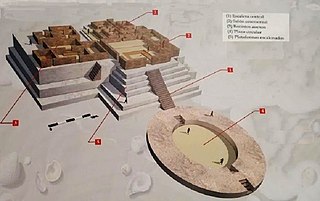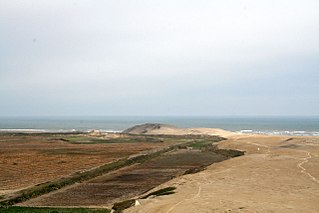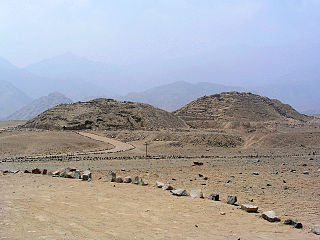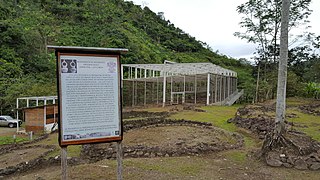Lauricocha culture is a sequence of preceramic cultural periods in Peru's history, spanning about 5,000 years from c. 8000 to 2500 BC.
The total prehistoric sequence in Peru spans 15,000 years, starting at about 13,000 BC when the first gatherer-hunter societies left their traces in the Ayacucho and Ancash highlands. These were populations that were migrating from the North American continent through Central America and populated the Andes. Traces of these early groups have been found in rock caves of Lauricocha, Pacaicasa and Guitarrero.
The Lauricocha Cave at an altitude of over 4000 m was discovered in 1957 near Lauricocha Lake and the Lauricocha River, one of the sources of the Marañón River, a headwater of the Amazon River. It contained human remains, the oldest found in Peru, which can be dated back to the last glacial period, c. 9,500 years ago.
The early Peruvian groups of gatherers and hunters traversed between the rugged highlands and the coastal areas, following the movement of the wild animal herds and the climatic change of the seasons. Lauricocha near Huánuco was one of the important mountain encampments. The art of working stone to arrow points and fine blades was sophisticated, and the people made cave paintings of animals, hunting scenes and dances.
- Lauricocha periods
- Lauricocha I: 8000 – 6000 BC (Andean preceramic III)
- Lauricocha II: 6000 – 4200 BC (Andean preceramic IV)
- Lauricocha III: 4200 – 2500 BC (Andean preceramic V)

The Neolithic or New Stone Age is an archaeological period, the final division of the Stone Age in Europe, Asia and Africa. It saw the Neolithic Revolution, a wide-ranging set of developments that appear to have arisen independently in several parts of the world. This "Neolithic package" included the introduction of farming, domestication of animals, and change from a hunter-gatherer lifestyle to one of settlement. The term 'Neolithic' was coined by Sir John Lubbock in 1865 as a refinement of the three-age system.
The 5th millennium BC spanned the years [5000 BCE - 4000 BCE), that is, inclusive of 5000 BCE but exclusive of 4000 BCE. It is impossible to precisely date events that happened around the time of this millennium and all dates mentioned here are estimates mostly based on geological and anthropological analysis.

In the classification of the archaeological cultures of North America, the Archaic period in North America, taken to last from around 8000 to 1000 BC in the sequence of North American pre-Columbian cultural stages, is a period defined by the archaic stage of cultural development. The Archaic stage is characterized by subsistence economies supported through the exploitation of nuts, seeds, and shellfish. As its ending is defined by the adoption of sedentary farming, this date can vary significantly across the Americas.

The Comb Ceramic culture or Pit-Comb Ware culture, often abbreviated as CCC or PCW, was a northeast European culture characterised by its Pit–Comb Ware. It existed from around 4200 BCE to around 2000 BCE. The bearers of the Comb Ceramic culture are thought to have still mostly followed the Mesolithic hunter-gatherer lifestyle, with traces of early agriculture.
The Archaic Southwest was the culture of the North American Southwest between 6500 BC and 200 AD (approximately).

Peruvian territory was inhabited 14,000 years ago by hunters and gatherers. Subsequent developments include the appearance of sedentary communities that developed agriculture and irrigation, and the emergence of complex socio-political hierarchies that created sophisticated civilizations, technology and monumental construction.
Chivateros is a prehistoric stone tool quarry and associated workshop located near the mouth of the Chillón river in the Ventanilla District, northwest of Lima, Peru.

Toquepala Caves are located near Toquepala mine, about 154 km (96 mi) from the city of Tacna, in the extreme southeast of Peru. They are notable for a number of rock paintings. The best known of them is the cave named Abrigo del Diablo.

Caral–Supe was a complex Pre-Columbian era society that included as many as thirty major population centers in what is now the Caral region of north-central coastal Peru. The civilization flourished between the fourth and second millennia BC, with the formation of the first city generally dated to around 3500 BC, at Huaricanga, in the Fortaleza area. From 3100 BC onward that large-scale human settlement and communal construction become clearly apparent, which lasted until a period of decline around 1800 BC. Since the early 21st century, it has been recognized as the oldest-known civilization in the Americas, and as one of the six sites where civilization separately originated in the ancient world.

Aspero is a well-studied Late Preceramic site archaeological complex located near the mouth of the Supe River, south of Supe Puerto, on the central coast of Peru. It forms part of the ancient Caral-Supe civilization and was occupied during the Late Archaic period, from before 3000 BCE to around 1800 BCE. It is connected culturally to the ancient city of Caral, located 25 km up-valley, for which it presumably served as a major fishery. The site covers an area of approximately 14 hectares and features numerous temples or huacas, of which the most prominent are the Huaca Alta, the Huaca de los ídolos and the Huaca de los Sacrificios. Remains of human sacrifice have been found in the latter, dated to about 4500 years ago.

"Las Vegas culture" is the name given to many Archaic settlements which flourished between 8000 BCE and 4600 BCE near the coast of present-day Ecuador. The name comes from the location of the most prominent settlement, Site No. 80, near the Las Vegas River and now within the city of Santa Elena. The Las Vegas culture represents "an early, sedentary adjustment to an ecologically complex coastal environment."
This timeline of prehistory covers the time from the appearance of Homo sapiens approximately 315,000 years ago in Africa to the invention of writing, over 5,000 years ago, with the earliest records going back to 3,200 BC. Prehistory covers the time from the Paleolithic to the beginning of ancient history.

Pre-Columbian Ecuador included numerous indigenous cultures, who thrived for thousands of years before the ascent of the Incan Empire. Las Vegas culture of coastal Ecuador, flourishing between 8000 and 4600 BC, is one of the oldest cultures in the Americas. The subsequent Valdivia culture in the Pacific coast region is another well-known early Ecuadorian culture. Ancient Valdivian artifacts from as early as 3500 BC have been found along the coast north of the Guayas Province in the modern city of Santa Elena.

Kotosh is an archaeological site near the town of Huánuco, Peru, consisting of a series of buildings comprising six periods of continuous occupation.

The Andean civilizations were South American complex societies of many indigenous people. They stretched down the spine of the Andes for 4,000 km (2,500 mi) from southern Colombia, to Ecuador and Peru, including the deserts of coastal Peru, to north Chile and northwest Argentina. Archaeologists believe that Andean civilizations first developed on the narrow coastal plain of the Pacific Ocean. The Caral or Norte Chico civilization of coastal Peru is the oldest known civilization in the Americas, dating back to 3500 BCE. Andean civilization is one of the six "pristine" civilizations of the world, created independently and without influence by other civilizations.

Huaca Prieta is the site of a prehistoric settlement beside the Pacific Ocean in the Chicama Valley, just north of Trujillo, La Libertad Province, Peru. It is a part of the El Brujo Archaeological Complex, which also includes Moche (culture) sites.

The history of human habitation in the Andean region of South America stretches from circa 15,000 BCE to the present day. Stretching for 7,000 km (4,300 mi) long, the region encompasses mountainous, tropical and desert environments. This colonisation and habitation of the region has been affected by its unique geography and climate, leading to the development of unique cultural and socn.

The Andean preceramic refers to the early period of human occupation in the Andean area of South America that preceded the introduction of ceramics. This period is also called pre-ceramic or aceramic.

Santa Ana (La Florida) is an important archaeological site in the highlands of Ecuador, going back as early as 3,500 BC. It is located in the Palanda Canton, just to the north of its regional capital of es:Palanda, in the Zamora-Chinchipe Province of Ecuador.

Tequendama is a preceramic and ceramic archaeological site located southeast of Soacha, Cundinamarca, Colombia, a couple of kilometers east of Tequendama Falls. It consists of multiple evidences of late Pleistocene to middle Holocene population of the Bogotá savanna, the high plateau in the Colombian Andes. Tequendama was inhabited from around 11,000 years BP, and continuing into the prehistorical, Herrera and Muisca periods, making it the oldest site of Colombia, together with El Abra, located north of Zipaquirá. Younger evidences also from the Herrera Period have been found close to the site of Tequendama in Soacha, at the construction site of a new electrical plant. They are dated at around 900 BCE to 900 AD.














